For professional soap making, you'll find HDPE and stainless steel molds are your most reliable options. HDPE molds offer excellent durability, withstand temperatures up to 200°F, and resist essential oil damage, while stainless steel provides superior heat tolerance during saponification. Though silicone molds feature easy release properties, they're less durable for commercial production. Wood requires liners and regular maintenance, making it less ideal. Understanding each material's specific advantages will transform your soap production process.
Essential Materials for Commercial Soap Molds
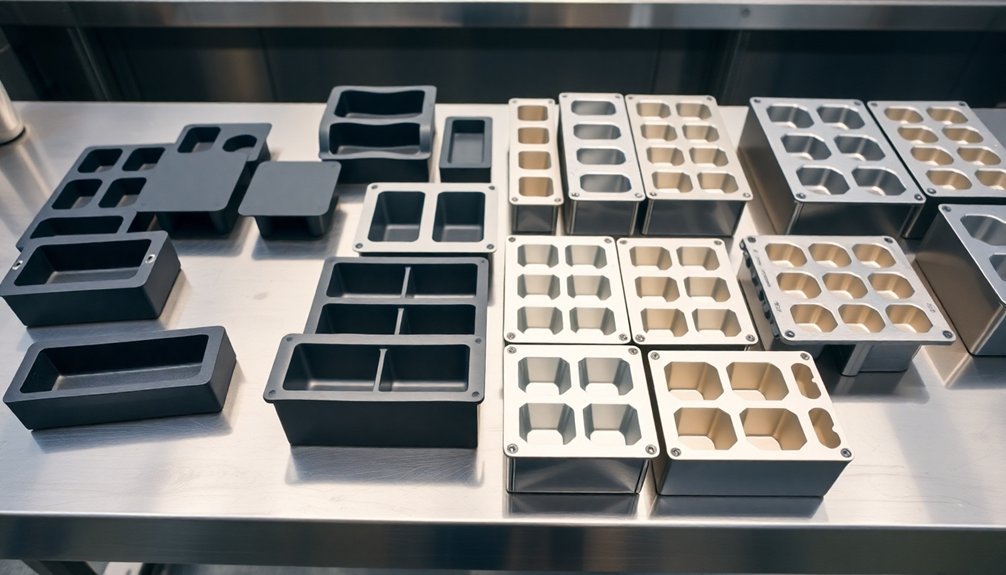
When selecting materials for commercial soap molds, you'll need to evaluate durability, temperature resistance, and chemical compatibility. Among the available options, HDPE stands out as the top choice, withstanding temperatures up to 200°F while resisting degradation from essential oils.
HDPE's superior durability and resistance to heat and essential oils make it the ideal material for commercial soap molds.
While silicone molds offer excellent release properties, they're prone to tearing and require careful maintenance. Stainless steel molds deliver outstanding durability but come at a premium price point and need proper insulation.
Though acrylic plastic molds look attractive, they often crack when exposed to oils, making them impractical for long-term use. Wooden molds, while budget-friendly and customizable, require liners and can warp over time.
For professional soap making, HDPE's combination of durability, temperature resistance, and chemical compatibility makes it the most reliable material for commercial soap molds.
HDPE Molds: The Industry Standard
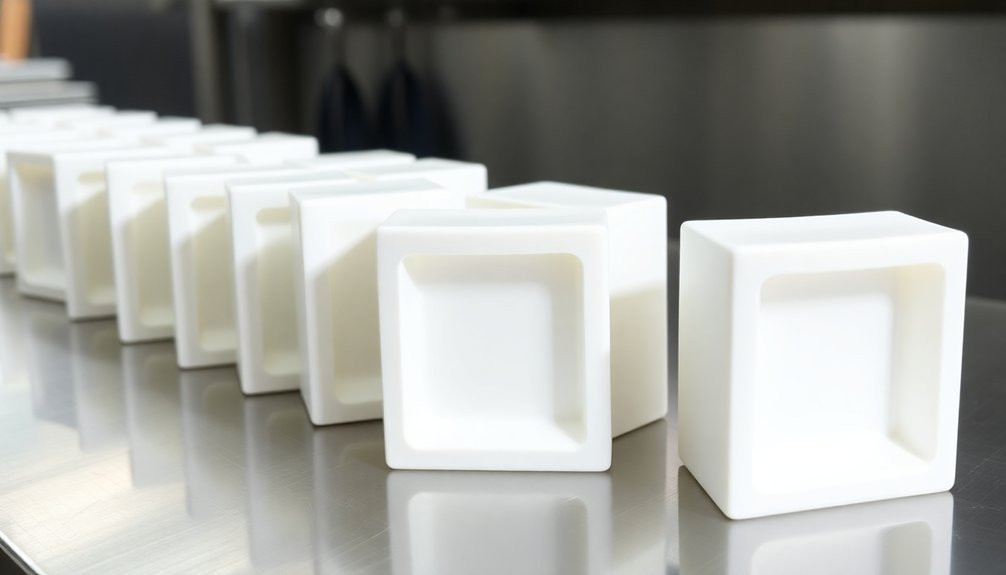
Manufacturers and soap artisans consistently choose HDPE molds as the gold standard for professional soap making.
You'll find these industry standard molds excel in durability and high temperature tolerance, withstanding heat up to 200°F while resisting degradation from essential oils and fragrances.
You won't need to worry about maintenance, as HDPE molds are easy to clean and maintain their quality through repeated use.
They're available in versatile configurations, including loaf designs and slab options, giving you flexibility in your production methods.
Many recipes don't require liners, which streamlines your soap-making process.
What sets HDPE molds apart is their superior ability to retain moisture and heat, promoting ideal saponification.
This unique feature guarantees better overall soap quality during the vital curing phase of production.
Comparing Wood vs. Plastic Production Molds
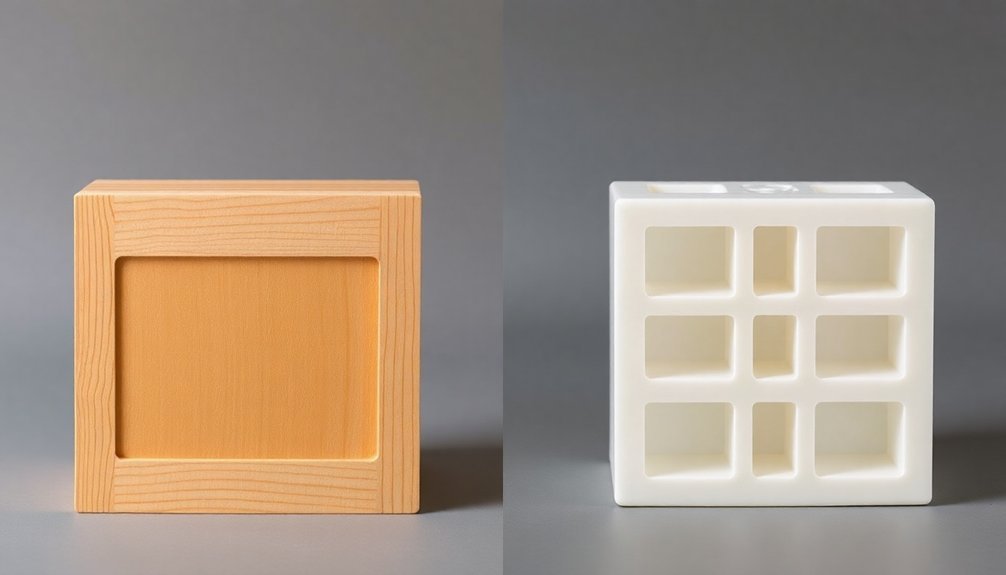
When choosing between wooden and plastic soap molds for your production needs, you'll find that both materials offer distinct advantages regarding durability, with wood providing excellent insulation and HDPE plastic resisting chemical degradation.
You'll notice that wooden molds typically cost less upfront and allow for custom sizing, though they'll require more maintenance and periodic liner replacement to prevent warping.
For scaling your production, plastic molds offer easier cleaning and consistent results across batches, while wooden molds may better accommodate larger volume needs due to their customizable nature.
Material Durability Comparison
Professional soap makers face an essential decision between wooden and plastic molds, as each material presents distinct durability characteristics that impact long-term production.
While wood molds offer excellent insulation, they're prone to warping and deterioration, requiring frequent replacement and liner additions for professional use.
HDPE plastic molds stand out for their superior durability, resisting essential oils and high temperatures up to 200°F. Their non-stick surface eliminates the need for liners, streamlining your production process.
Though acrylic plastic molds look attractive, they're less suitable for professional use due to their vulnerability to cracking and shorter lifespan.
For those seeking a middle ground, stainless steel molds deliver exceptional durability but need additional insulation for ideal saponification, unlike wood's natural insulating properties.
Cost and Maintenance Analysis
Understanding the true cost of soap molds requires looking beyond initial price tags to factor in long-term maintenance needs and replacement frequency.
While wood soap molds might seem more budget-friendly upfront, you'll need to take into account their higher maintenance demands and shorter lifespan.
Plastic production molds, especially HDPE, offer superior durability and require less intensive cleaning, which saves you time and effort in daily operations.
Though wood molds excel at insulating cold process soap, they're prone to warping and deterioration from essential oils and lye exposure. You'll need to replace them more frequently than their plastic counterparts.
When calculating initial costs, factor in that wood molds need liners and more frequent replacements, while plastic molds offer better longevity despite potentially higher upfront costs.
Your choice should balance immediate budget constraints with long-term maintenance requirements.
Production Scaling Capabilities
Selecting the right mold type becomes even more significant as your soap making operation expands.
Wood molds excel in large batches, providing superior insulation that speeds up saponification and supports the curing process through consistent heat retention. You'll need liners, but the trade-off is worth it for medium to high-volume production.
HDPE plastic molds offer different scaling advantages. Their non-stick surface eliminates the need for liners, and they're lightweight, making them easier to handle during high-volume operations.
You'll appreciate their durability at temperatures up to 200°F and the quick cleaning turnaround that enhances production efficiency. While they don't match wood's insulation properties, plastic molds compensate with practical benefits that can streamline your manufacturing process, especially when you're scaling up operations rapidly.
Temperature Resistance in Professional Molds
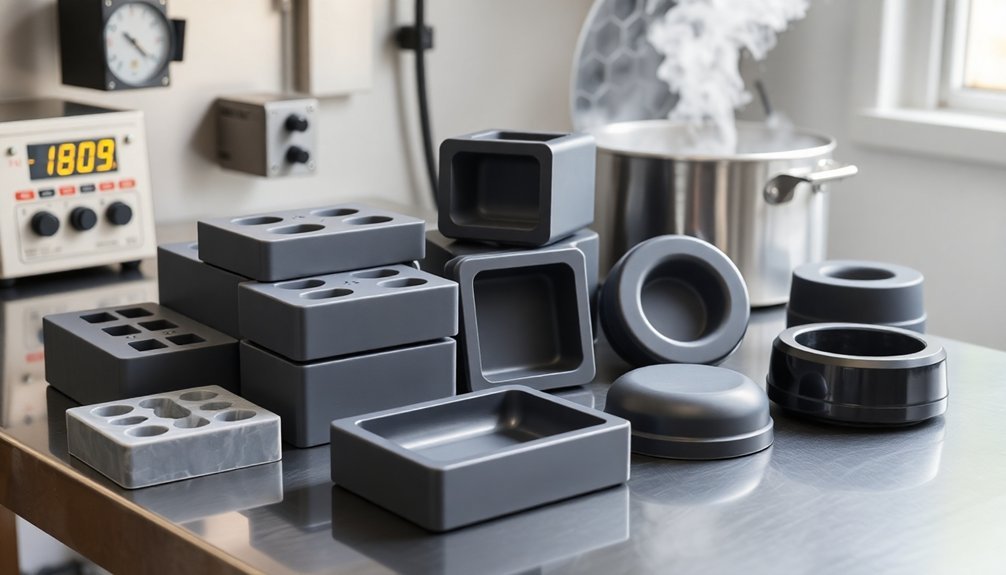
When selecting professional soap molds, you'll find that temperature resistance varies greatly across materials, with HDPE molds handling up to 200°F and silicone molds safely operating up to 180°F.
You'll want to take into account that stainless steel molds offer superior heat tolerance during saponification, while acrylic molds can crack under high temperatures and essential oil exposure.
Your choice of mold material directly impacts the safe operating temperature range for your soap-making process, making it essential to match the mold's heat resistance to your intended technique.
Heat Tolerance Across Materials
Temperature resistance plays an essential role in determining which professional soap molds will best suit your needs.
You'll find that different materials offer varying levels of heat tolerance, directly impacting your soap making techniques.
- HDPE molds withstand temperatures up to 200°F with a melting point of 266°F, making them reliable for most soap making processes.
- Silicone molds showcase superior heat-resistant properties, handling temperatures up to 400°F, perfect for both cold process and melt and pour methods.
- Stainless steel molds excel in high temperatures and promote even saponification, though they're a pricier investment.
- Acrylic plastic molds, while attractive, have limited heat tolerance and may crack when exposed to oils.
When selecting your molds, consider these temperature thresholds to guarantee your equipment maintains integrity throughout the soap making process.
Safe Operating Temperature Ranges
Understanding safe operating temperature ranges guarantees your professional soap molds remain functional and produce consistent results.
When choosing molds for your soap-making processes, you'll find that silicone molds offer the widest temperature range, functioning from -40°F to 450°F, making them versatile for various techniques.
HDPE professional soap molds work well up to 200°F, providing reliable performance for most saponification needs.
While acrylic molds might look attractive, they're not your best choice for high-temperature applications, as they're susceptible to cracking and degradation when exposed to heat and essential oils.
For premium heat retention and durability, stainless steel molds excel at high temperatures during saponification.
You'll want to avoid any materials that can't withstand the heat generated during soap making, as they'll compromise your final product's quality.
Chemical Compatibility of Mold Materials
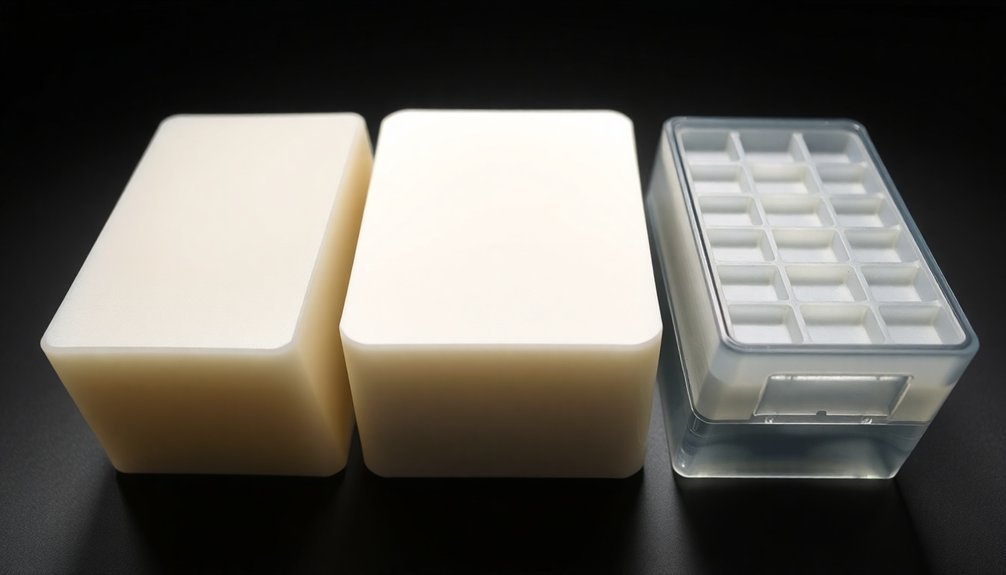
Since soap making involves strong chemicals and oils, selecting the right mold material is essential for both product quality and mold longevity.
HDPE molds offer superior chemical compatibility with essential oils and fragrance oils, making them a top choice for professional soap makers. You'll want to evaluate how different materials react to the soap-making process:
- HDPE molds won't degrade or react with saponification chemicals, ensuring long-term reliability.
- Acrylic soap molds, while attractive, can crack when exposed to oils and heat.
- Wooden molds require liners and may warp from lye exposure.
- Stainless steel molds provide excellent chemical compatibility but need proper insulation.
While silicone molds are popular for their flexibility, they're prone to tearing and degradation from repeated lye exposure.
For consistent professional results, prioritize materials that maintain their integrity during chemical interactions.
Scaling Production With Large-Format Molds
Your soap manufacturing efficiency dramatically improves when you switch to large-format molds that handle 35-120 pounds per batch.
With these professional molds, you'll reduce labor costs while maintaining consistent quality since they promote better heat retention and ideal saponification.
You can maximize your production output by using properly lined molds that guarantee easy release and streamlined cutting of multiple bars at once.
Manufacturing Efficiency Techniques
When scaling up soap production, large-format molds become indispensable tools for maximizing efficiency and output.
Whether you're using HDPE plastic or DIY wood molds, you'll find these solutions can handle batches from 35 to 120 pounds, dramatically cutting your production time.
To improve manufacturing efficiency techniques, you'll want to incorporate silicone liners and freezer paper for easy release.
- Oil heaters and wrap-around silicone heaters enable simultaneous batch processing
- Multi-bar cutters guarantee uniform sizing and speed up post-production work
- Large soap molds with proper liners minimize waste and improve workflow
- Custom wooden molds offer cost-effective scaling solutions
Maximizing Batch Size Success
As soap makers shift to larger production scales, mastering large-format molds becomes essential for maintaining quality while increasing output.
You'll find that HDPE and wooden molds can accommodate 35 to 120 pounds of soap, dramatically boosting your production capacity while ensuring consistency across batches.
To maximize your success with larger batch sizes, focus on proper lining of your molds. This step is important for easy release and minimal waste during demolding.
When you're scaling up your artisan soaps, efficient production methods become crucial. Consider investing in specialized mold designs like air cutter molds, which will streamline your cutting process and reduce turnaround time.
Large-format molds aren't just about bigger batches – they're about smart scaling that lets you meet growing demand while maintaining your soap's artisanal quality.
Durability Factors in Commercial Grade Materials
The selection of durable materials plays a critical role in producing reliable soap molds for commercial operations. When you're choosing commercial grade molds, HDPE stands out as the top performer, withstanding essential oils and high temperatures without degrading.
While silicone offers flexibility, it's not as durable for heavy-duty production.
- HDPE molds maintain their integrity up to 200°F and resist essential oil damage
- Stainless steel provides excellent durability but requires proper insulation
- Wooden molds need liners and can warp with repeated use
- Acrylic plastic molds, though visually appealing, crack under frequent exposure
For long-term commercial success, you'll want to prioritize materials that can handle repeated use.
While stainless steel and HDPE cost more initially, they'll outperform cheaper alternatives like wooden or acrylic plastic molds in the long run.
Cost Analysis of Professional Mold Types
Understanding the cost landscape of professional soap molds helps balance durability with budget constraints.
Smart soap makers know that finding the right mold means weighing both quality and cost to make sustainable business choices.
You'll find HDPE molds are a cost-effective choice, ranging from $20 to $100, offering excellent durability for your investment.
Silicone molds provide flexibility at $15 to $60, though they'll need regular maintenance.
If you're considering wooden molds, expect to spend $30 to $150, factoring in additional lining materials for your production needs.
Acrylic molds, priced between $25 and $80, offer aesthetic appeal but require careful handling to prevent damage.
For high-volume production, professional-grade molds like stainless steel options represent a significant investment at over $200.
While they're the most expensive initially, their long-term durability and reliability make them worthwhile for serious soap makers focused on consistent, large-scale manufacturing.
Maintenance Requirements by Material Type
Each type of soap mold requires distinct maintenance routines to guarantee longevity and consistent production quality.
From silicone soap molds needing saltwater treatments to wooden molds demanding protective liners, proper care guarantees your investment's durability.
- Clean silicone molds with baking soda or saltwater to remove lingering essential oils and prevent scent transfer between batches.
- Protect wooden molds with grease-proof paper and maintain them regularly to prevent warping that could compromise your soap's shape.
- Rinse HDPE plastic molds thoroughly after each use, especially when working with essential oils, to maintain their structural integrity.
- Handle acrylic molds with extra care during cleaning to preserve their clarity, and keep stainless steel molds well-insulated during use while cleaning promptly to prevent corrosion.
These maintenance requirements will greatly extend your molds' lifespan and maintain their performance.
Material Impact on Soap Quality
While crafting professional-grade soap requires attention to many variables, your choice of mold material plays an essential role in determining the final product's quality.
HDPE and silicone molds offer superior insulation and moisture retention, which directly enhances the saponification process and improves soap quality.
You'll find that silicone molds excel at releasing finished soaps without damage, ensuring a flawless surface.
While wooden molds provide good insulation for cold process soap, they'll need liners that can affect your final results.
Don't be fooled by attractive acrylic molds – their poor heat resistance can compromise your soap's integrity.
For commercial settings, you'll want to prioritize materials like HDPE, which maintains consistent quality across large batches due to its exceptional durability and heat-resistant properties.
Environmental Considerations in Mold Selection
As sustainability becomes increasingly essential in soap making, your choice of mold material can greatly impact the environment. When selecting professional molds, you'll want to take into account both durability and eco-friendliness.
HDPE stands out as a top choice, offering resistance to essential oils while remaining fully recyclable.
- HDPE molds provide the best balance of durability and environmental responsibility, lasting longer than other options.
- Silicone molds, though reusable, may degrade over time and pose recycling challenges.
- Wooden molds can be sustainable when sourced responsibly, but require biodegradable liners to prevent waste.
- Acrylic molds, while attractive, have shorter lifespans and create more waste.
To minimize your environmental footprint, pair your molds with recyclable or biodegradable liners. This combination guarantees professional results while maintaining eco-conscious production standards.
Safety Certifications for Industrial Molds
Professional soap makers must understand the safety certifications required for industrial molds before scaling their production.
When selecting molds, you'll need to verify compliance with FDA regulations, particularly for molds intended for cosmetic products and food-contact materials.
Look for molds made from HDPE, as this material offers excellent temperature resistance and won't degrade when exposed to essential oils.
HDPE molds are a smart choice for soap making, delivering superior heat resistance while standing up to essential oil exposure.
You'll want to confirm your molds have passed chemical leaching tests to prevent harmful substances from contaminating your soap formulations.
Check that manufacturers have conducted durability and structural integrity testing under high-pressure conditions. These tests confirm the mold's ability to maintain its shape during repeated use.
Additionally, verify that your molds meet ISO standards and other relevant safety certifications, as proper documentation is vital for commercial production.
Frequently Asked Questions
What Is the Best Material for Soap Molds?
You'll find HDPE is your best soap mold material choice. It's extremely durable, handles high temperatures up to 200°F, resists oil degradation, and cleans easily while consistently producing quality soap bars.
What Are the Raw Materials for Soap Making Industry?
You'll need fats/oils (coconut, palm, olive), alkalis (sodium/potassium hydroxide), essential oils for fragrance, colorants (clays, micas), additives (exfoliants, moisturizers), and preservatives to make soap commercially.
What Is the Best Wood for Soap Molds?
You'll find non-treated pine is your best choice for soap molds. It's affordable, easy to find, and provides excellent insulation for cold process soap. If you want durability, consider hardwoods like birch.
Are Silicone Molds Good for Soap Making?
Yes, you'll find silicone molds excellent for soap making. They're non-stick, heat-resistant, and easy to use. Your soaps will release easily, and you can create intricate designs. Plus, they're durable and long-lasting.
In Summary
Your choice of professional soap molds will directly impact your production quality and efficiency. Whether you've selected HDPE, silicone, or wood materials, guarantee they meet industry safety standards and temperature requirements. Consider your specific production needs, maintenance capabilities, and environmental goals when making your final decision. By choosing the right mold material, you'll maximize your soap making success and maintain consistent quality.

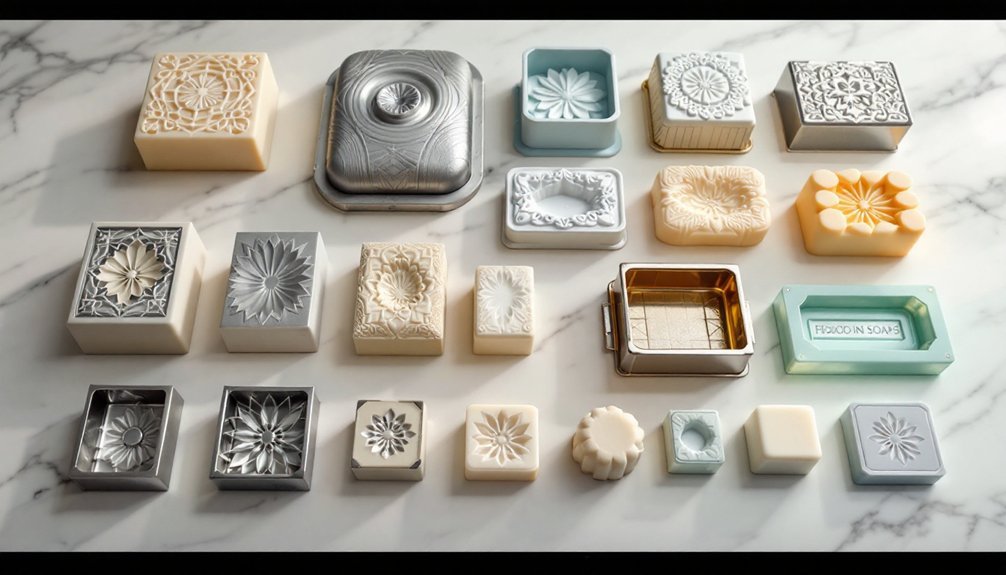



Leave a Reply